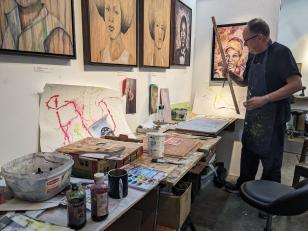Clients in the News
NPR Radio Interview. Artistry: Elevating random found objects
Northern California Public Media
October 25, 2023
by Marc Albert
 For construction worker-turned-teacher-turned-artist, Santa Rosa’s Nick Mancillas says he can’t and won’t stop creating.
For construction worker-turned-teacher-turned-artist, Santa Rosa’s Nick Mancillas says he can’t and won’t stop creating.
“I think that finding something artistic is more of a journey, like you start off at point A and you don’t know where point B is, you’re kind of wandering around on a trail—you sort of do know where you’re going, but I think that the process of discovery and the making of it, and the excitement of discovery, is the excitement the viewer will feel when they are seeing it, the end product,” Mancillas said.
As local artists gear up for the annual street parade and festival-called Winterblast–a sort-of family-friendly, one-night-only mini-Burning Man, Mancillas is perfecting a piece in a dim, cluttered studio not much bigger than a walk-in closet.
With three decades under his belt as a high school art and Spanish teacher in Santa Rosa, Mancillas is looking ahead to spending more time in the studio—he retires in the spring.
While formal training has its place, Mancillas said the artistic spark is within us all—we just need to unlearn certain things.
By high school age, creativity can succumb to self-consciousness–fear of ridicule and perhaps too much self revelation.
Mancillas said in the classroom, he’d work to overcome that.
“I would spend a lot of time tricking them into showing them that they were artistic, so I would do a warm up activity in class,” Mancillas said. “They wouldn’t realize it, but I was teaching them how to draw a dragon tattoo, kids always like that type of thing, but I would say, ‘start off with a sideways hook,’ and I would say, ‘now, you’ll go down,’ and I would describe step-by-step what we’re doing and then I didn’t tell them that they were doing a dragon’s eyeball or doing a small dragon’s ear, or doing scales, and they would just get involved, they would enjoy it. But if you just gave them a picture of a dragon and say ‘draw the dragon’ they would go, ‘I can’t do that.”
As far as elevating one’s craft to the point of earning recognition, like anything, it takes practice, determination and drive.
“You actually just have to put in the time, and you can never look at too much art, and it helps to have a good critique, with someone that you trust, but if you asked ten different people about your work, you’re going to get ten different opinions. Ultimately, the artist themselves has to know what their art’s about, and if they are on the right track or not,” Mancillas added.
At the same time, the act of creation isn’t dependent on pristine canvases or pricey supplies, another perspective built in the classroom.
“I would like to deny that I was ever a high school art teacher, but I can’t,” Mancillas said. “Part of the necessity and survival in that job, forced me to go and grab used cardboard, used whatever—materials that I had at the ready to make something. Some of the things, the most interesting things my kids would do–dealt with magazines, which are a resource we don’t have much of anymore. But magazine color is just so bright, it’s just so brilliant and I still love using it myself.”
Mancillas works mainly in paint and collage, and will distress found objects to hint at a wider story. Incorporating brush strokes and remnants of earlier work into a new piece—as if even when we make major life changes, our earlier experiences can’t quite be erased.
“I have always like things that have a visual mileage to it, in other words, I add textures and collage and paint, I’ll sand over the magazine pieces and get a really cool look to it, I was very influenced when I was in grad school in Boston by Art de-Provera, which is like any old anybody could make art, they used really common materials and of course had a lot of Italian attitude. I think the movement lasted about ten years or so, I kind of clicked into that. I used to work in construction before I became a teacher and so I’m very familiar with Home Depot materials and I always thought, in my artistic arrogance that I can, through my own alchemy, I can turn something that is not valuable into something valuable,” Mancillas said.
As to his ambitions as an artist?
“Hmm, to be recognized as pretty damn good, and I’m not there yet,” Mancillas said. “Art is really about putting enough time and focus, energy and reflection into your work.”
Mancillas’s studio is within the Backstreet Gallery at 312 South A Street in Santa Rosa. The gallery is open from 11 to 3 on weekends.
Winterblast, the annual Santa Rosa art celebration, which is actually halfway through autumn, is scheduled for Saturday, November 4 from 3-8 p.m.

